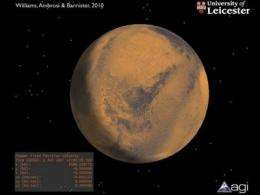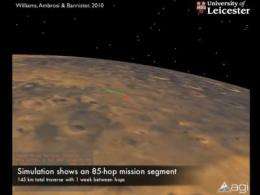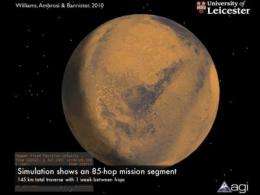Mars 'hopper': Space scientists develop new breed of space vehicle

Scientists and engineers at the internationally acclaimed Space Research Centre at the University of Leicester are developing a conceptual motor design for a Mars 'hopping' vehicle which should lead to a greater understanding of the 'Red Planet'.
Their research findings have been published this month by the Proceedings of the Royal Society A.
Robots exploring Mars can carry scientific instruments that measure the physical and chemical characteristics of the Martian surface and subsurface, analyse the environment and look for evidence of past or present life. Wheeled rovers have made extraordinary discoveries despite only exploring a small fraction of the planet.
The research has an international flavour. The University of Leicester has been working with a number of collaborators including Astrium Ltd in the UK and Center for Space Nuclear Research, Idaho, USA. The focus in the UK has been the development of a large-scale (400 kg) Mars Hopper concept that can fly in 1km 'hops'. This is an exciting concept that should be considered further as a complement to rover and orbital missions.
The Hopper can collect fuel between hops by compressing gas from the Martian atmosphere and can fly quickly between sites, powered by a long-life radioisotope power source. It could therefore study hundreds of locations over a lifetime of several years.
The Leicester research focused on the rocket motor, looking at its size and materials.

Dr Richard Ambrosi, at the Leicester Space Research Centre, commented:
"The improved mobility and range of a hopping vehicle will tell us more about the evolution of Mars and of the Solar System and may answer questions as to whether there was life in the past, whether Mars was wetter in the past and if so where that water went."
Dr Nigel Bannister added: "The Hopper is different from other rovers because of its power source. In one mode the heat source generates electric power to drive a compressor to gather the carbon dioxide propellant from the Martian atmosphere. The heat source then stores thermal energy and injects it into the propellant, which is accelerated out of a rocket nozzle to provide thrust."
Dr Hugo Williams said: "At Leicester we have concentrated on the motor and design features which translate into the performance of the vehicle.
"Our findings have resulted in a hop range of 1km, for a relatively large vehicle with a large suite of scientific instruments on board. We also looked at the geometry and the best materials for the motor core.

"Our interest in the materials aspect is particularly relevant because we are also engaged in collaborative research with our colleagues in Materials Engineering here at Leicester, and Queen Mary University of London to explore how material properties of materials for use in the space nuclear systems of the future can be enhanced through novel processing and manufacturing techniques."
More information: http://rspa.royalsocietypublishing.org/content/early/2010/11/11/rspa.2010.0438.short?rss=1
Provided by University of Leicester



















